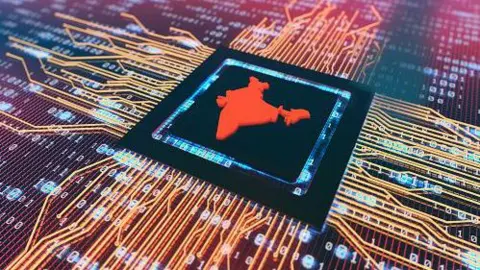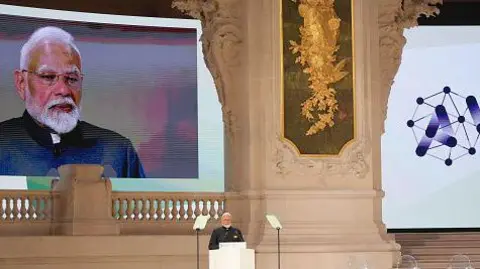India AI: As DeepSeek and ChatGPT surge, is Delhi falling behind?

 Getty Images
Getty ImagesTwo years after ChatGPT took the world by storm, China’s DeepSeek has sent ripples through the tech industry by collapsing the cost for developing generative artificial intelligence applications.
But as the global race for AI supremacy heats up, India appears to have fallen behind, especially in creating its own foundational language model that’s used to power things like chatbots.
The government claims a homegrown equivalent to DeepSeek isn’t far away. It is supplying startups, universities and researchers with thousands of high-end chips needed to develop it in under 10 months.
A flurry of global AI leaders have also been talking up India’s capabilities recently.
After being initially dismissive, OpenAI CEO Sam Altman this month said India should be playing a leading role in the AI revolution. The country is now OpenAI’s second largest market by users.
Others like Microsoft have put serious money on the table – committing $3bn (£2.4bn) for cloud and AI infrastructure. Nvidia’s Jensen Huang also spoke of India’s “unmatched” technical talent as a key to unlocking its future potential.
With 200 startups working on generative AI, there’s enough entrepreneurial activity under way too.
But despite having key ingredients for success in place, India risks lagging behind without basic structural fixes to education, research and state policy, experts say.
China and the US already have a “four to five year head-start”, having invested heavily in research and academia and developed AI for military applications, law enforcement and now large language models, technology analyst Prasanto Roy told the BBC.
Though in the top five globally on Stanford’s AI Vibrancy Index – which ranks countries on metrics such as patents, funding, policy and research – India is still far behind the two superpowers in many key areas.
China and the US were granted 60% and 20% of the world’s total AI patents between 2010 and 2022 respectively. India got less than half a percent.
India’s AI startups also received a fraction of the private investment that US and Chinese companies got in 2023.
India’s state-funded AI mission, meanwhile, is worth a trifling $1bn compared with the staggering $500bn the US has earmarked for Stargate – a plan to build massive AI infrastructure in the US – or China’s reported $137bn initiative to become an AI hub by 2030.
 Getty Images
Getty ImagesWhile DeepSeek’s success has demonstrated that AI models can be built on older, less expensive chips – something India can take solace from – lack of “patient” or long-term capital from either industry or government is a major problem, says Jaspreet Bindra, founder of a consultancy that builds AI literacy in organisations.
“Despite what has been heard about DeepSeek developing a model with $5.6m, there was much more capital behind it.”
Lack of high-quality India-specific datasets required for training AI models in regional languages such as Hindi, Marathi or Tamil is another problem, especially given India’s language diversity.
But for all its issues, India punches far above its weight on talent – with 15% of the world’s AI workers coming from the country.
The issue though, as Stanford’s AI talent migration research shows, is that more and more of them are choosing to leave the country.
This is partly because “foundational AI innovations typically come from deep R&D in universities and corporate research labs”, Mr Bindra says.
And India lacks a supporting research environment, with few deep-tech breakthroughs emerging from its academic and corporate sectors.
The enormous success of India’s payments revolution was due to strong government-industry-academia collaboration – a similar model, he says, needs to be replicated for the AI push.
The Unified Payment Interface (UPI), a digital payment system developed by a government organisation, has revolutionised digital payments in India, allowing millions to transact at the click of a button or by scanning a QR code.
 Getty Images
Getty ImagesBengaluru’s $200bn outsourcing industry, home to millions of coders, should have ideally been at the forefront of India’s AI ambitions. But the IT companies have never really shifted their focus from cheap service-based work to developing foundational consumer AI technologies.
“It’s a huge gap which they left to the startups to fill,” says Mr Roy.
He’s unsure though whether startups and government missions can do this heavy lifting quickly enough, adding that the 10-month timeline set by the minster was a knee-jerk reaction to DeepSeek’s sudden emergence.
“I don’t think India will be able to produce anything like DeepSeek at least for the next few years,” he adds. It is a view many others share.
India can, however, continue to build and tweak applications upon existing open source platforms like DeepSeek “to leapfrog our own AI progress”, Bhavish Agarwal, founder of one of India’s earliest AI startups Krutrim, recently wrote on X.
In the longer run though, developing a foundational model will be critical to have strategic autonomy in the sector and reduce import dependencies and threats of sanctions, say experts.
India will also need to increase its computational power or hardware infrastructure to run such models, which means manufacturing semiconductors – something that’s not taken off yet.
Much of this will need to fall in place before the gap with the US and China is narrowed meaningfully.
World News || Latest News || U.S. News
Source link




